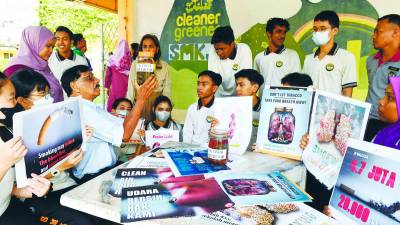
Vape wave: Teens face new threat
MALAYSIA’S fight against tobacco is entering a troubling new phase. While the country has made commendable progress in reducing cigarette smoking among teenagers, a new and insidious trend has emerged – vaping. Marketed as a safer alternative to cigarettes, vaping is gaining popularity among adolescents, threatening to undermine national public health goals under the 13th Malaysia Plan (13MP). Medical professionals warn that vaping is far from harmless. Nicotine exposure during adolescence can impair brain development, weaken memory and concentration, and reduce learning capacity. More worryingly, it heightens vulnerability to anxiety and depression while serving as a gateway to conventional smoking and even other forms of substance abuse. Dangerous substitution The Adolescent Health Survey 2022 offers a sobering picture. The proportion of teenagers aged 13 to 17 who smoke cigarettes has dropped sharply from 13.8% in 2017 to 6.2% in 2022. At first glance, this is a success story but the decline in smoking has been offset by a surge in vaping. Within the same five-year period, teenage vape use jumped from 9.8% to 14.9%. The reason is clear – vape products are aggressively marketed with youth-friendly flavours such as mango, strawberry and cotton candy, deliberately masking nicotine’s harsh taste. These products are packaged as trendy lifestyle accessories, normalising nicotine use among students who may otherwise avoid tobacco. Despite the government’s emphasis on strengthening healthcare systems, the plan does not include explicit targets for reducing vaping prevalence among youth or adults. While Strategy D3.1 under the 13MP acknowledges the need for health taxes on tobacco, alcohol and vaping products, the absence of clear benchmarks for e-cigarettes has created dangerous regulatory blind spots. This lack of clarity allows manufacturers and retailers to exploit loopholes. Fragmented oversight among different enforcement agencies has further weakened regulatory effectiveness, enabling vape products to reach students with relative ease. The challenge is most visible in schools. Data from Sistem Sahsiah Diri Murid (SSDM) recorded 19,450 cases of students caught vaping in 2024, which is five times higher than the 3,704 cases of cigarette smoking recorded in the same year. This dramatic shift in nicotine consumption patterns underscores how vaping has overtaken cigarettes as the primary addiction among school-aged youths. Although vaping in schools has been banned since 2015, enforcement remains patchy. Weak detection mechanisms, inconsistent discipline and minimal deterrents have allowed the problem to fester. New legislation: A step forward but not enough The Control of Smoking Products for Public Health Act 2024, set to take effect on Oct 1, aims to address these gaps. It prohibits vape sales to minors, restricts outlets near schools and imposes strict penalties on teachers and students. Repeat student offenders face suspension of up to 14 days or even expulsion while teachers caught vaping may face fines of up to RM10,000 or two years in prison. Yet, punitive measures targeting students risk being counterproductive. Automatic suspensions and expulsions could push vulnerable teenagers further away from support systems. A more constructive approach would be to scale punishments based on severity and prioritise rehabilitation through community service, educational workshops or environmental cleanup initiatives. Malaysia’s regulatory stance lags behind regional and international peers. Australia has enforced a prescription-only model for nicotine e-liquids and banned flavoured vapes altogether while New Zealand has restricted sales to specialist stores and mandated strict age and identity verification. By contrast, Malaysia lacks a centralised verification system and has yet to implement restrictions on flavours. This regulatory vacuum makes it easier for minors to access vape products compared to cigarettes. To address these challenges and strengthen regulatory oversight, 13MP should prioritise the integration of blockchain and artificial intelligence to deliver end-to-end visibility over e-cigarette supply chain. A blockchain-backed registry of every vape transaction, recording manufacturers, distributors, retailers and purchasers can create an immutable audit trail. The establishment of an AI analytics would enable automated monitoring to detect suspicious purchasing patterns. Alongside technological tools, prevention must prioritise education and awareness. Youth-focused campaigns on TikTok, YouTube and other digital platforms can help counter the glamourisation of vaping. Schools should be equipped with trained personnel capable of detecting early signs of nicotine dependence and providing accessible cessation support. Avoiding a public health crisis Malaysia has made important strides in reducing cigarette smoking among youths but complacency is not an option. Without decisive and coordinated action, vaping risks becoming the new “normal” for an entire generation. The sharp rise in school-based vaping cases is proof that nicotine addiction is not being eliminated; it is simply evolving. Several groups are calling for stronger regulations and enforcement. The authorities must stop issuing licences for new vape shops and possibly cease existing licences. Parents must be provided with resources to recognise signals of vaping in their children. The 13MP’s promise of a healthier, more resilient society will depend on tackling the vape epidemic seriously before it takes permanent root. Nur Zalikhaa’ Zainal Abidin is a research analyst at Institut Masa Depan Malaysia. Comments: letters@thesundaily.com